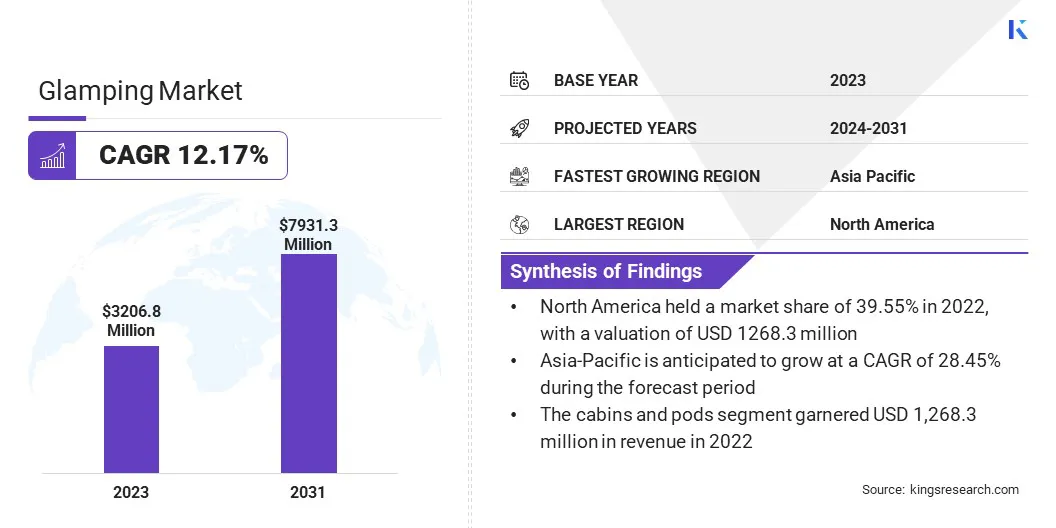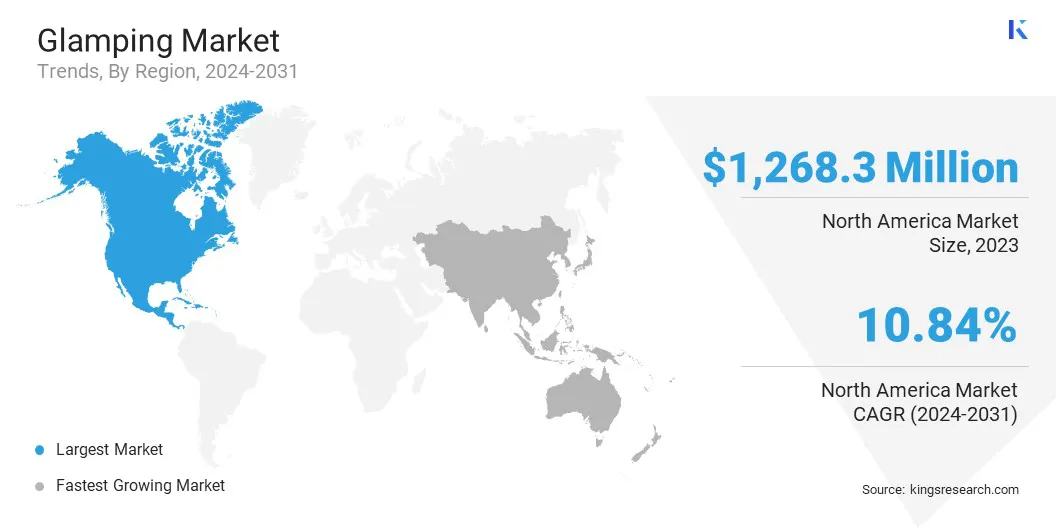Glamping Market Size
The global Glamping Market size was valued at USD 3,206.8 million in 2023 and is projected to reach USD 7,931.3 million by 2031, growing at a CAGR of 12.17% from 2024 to 2031. In the scope of work, the report includes products offered by companies such as Under Canvas, Bubble Tree, The Luxe Nomad, Canopy & Stars Ltd., Glamping Society, Purepods, Treebones Resort, Tanja Lagoon Camp, EcoCamp Patagonia, Sandy Pines Campground and Others.
The global glamping market is experiencing significant growth, driven by a paradigm shift in traveler preferences. Consumers are increasingly seeking exceptional outdoor experiences that seamlessly blend adventure with luxury. This is exemplified by the rise of social media influencers who showcase the aspects of glamping, propelling the industry forward through captivating imagery and positive online reviews.
Market growth is further fueled by the diversification of glamping accommodation options. In addition to the traditional canvas tent, travelers can choose from a variety of accommodations such as luxurious cabins nestled amidst forests, cozy pods offering breathtaking panoramic vistas, or even trendy treehouses. This expanded variety caters to a broader demographic, attracting individuals, couples, families, and eco-conscious travelers interested in sustainable lodging options.
However, the glamping industry faces certain challenges. Seasonality may constrain operations in some locations, as harsh weather conditions restrict the experience of the natural environment. Additionally, glamping experiences often come at a premium price point compared to traditional camping, potentially deterring budget-conscious travelers. Moreover, regulatory frameworks governing glamping can vary geographically, requiring operators to navigate permitting processes and ensure compliance with local regulations.

Analyst’s Review
The glamping market boasts a promising outlook with a robust projected growth trajectory. The industry's growing emphasis on unique gateaways, luxurious amenities, and the potential for sustainable practices positions it favorably to capture a significant share of the travel market. By addressing seasonality concerns, implementing strategic pricing models, and navigating regulatory environments, glamping operators can solidify their standing as a leader in the experiential travel sector.
Market Definition
The global glamping market refers to the segment within the tourism and hospitality industry that offers travelers a luxurious camping experience while maintaining a connection with nature. Glamping, derived from ‘glamorous camping’ provides an alternative to traditional camping by combining the adventure of outdoor living with the comfort and amenities of upscale accommodations. It caters to individuals seeking unique and memorable travel experiences, ranging from families and couples to solo adventurers.
Glamping accommodations come in various forms, including safari tents, yurts, treehouses, cabins, and luxury RVs, each offering a distinct ambiance and level of luxury. The market encompasses a diverse range of destinations, including remote wilderness areas, scenic landscapes, and urban environments, allowing travelers to immerse themselves in nature while maintaining a level of comfort or convenience.
Glamping Market Dynamics
The contemporary traveler demographics is increasingly inclined toward immersive and unique experiences, surpassing traditional vacation and tourism activities. Increasing demand for adventures that facilitate a profound connection with nature is propelling the demand for glamping. It has emerged as a significant catalyst for this trend, offering a harmonious combination of stunning natural environments and luxurious amenities. This fusion of adventure and luxury deeply resonates with travelers seeking transformative journeys. The burgeoning trend is notably influenced by the pervasive impact of social media, wherein travel influencers leverage captivating imagery and digital endorsements, thereby fueling market growth.
Moreover, the glamping landscape has evolved significantly from traditional canvas tents, boasting an array of lodging choices to accommodate a broader spectrum of travelers. Eco-conscious travelers seek comfort in sustainable options, such as recycled-material treehouses, which align with their environmental principles. This diverse selection ensures that there exists a glamping experience tailored to cater to various preferences, thereby attracting a wider audience and stimulating market expansion.
Additionally, rising disposable incomes globally, particularly in developing economies, are empowering consumers to spend more on leisure activities. This results in a greater willingness to invest in unique and memorable travel experiences. Furthermore, a generational shift in consumer preferences is fueling the growth of the glamping market. Millennials and Gen Z are increasingly prioritizing experiences over material possessions, which is fostering glamping market development.
Despite its growth trajectory, the glamping market faces several challenges that necessitate careful consideration. One significant hurdle is the regulatory landscape, with varying zoning laws, building codes, and environmental regulations posing obstacles to the development and operation of glamping sites.
Additionally, maintaining a balance between luxury and sustainability presents a significant challenge, as consumers increasingly prioritize eco-friendly practices. However, with increasing demand and adoption of sustainable construction practices, the market is anticipated to grow substantially over 2024-2031.
Segmentation Analysis
The global glamping market is segmented based on accommodation type, age group, and geography.
By Accommodation Type
Based on accommodation type, the market is categorized into cabins and pods, treehouses, tents, tiny homes, and others. The cabins and pods segment dominated the market, accounting for USD 1,268.3 million in 2023. Cabins and pods offer a blend of comfort and rustic charm, appealing to a wide range of travelers, including couples, families, and groups. Their spacious interiors and amenities, such as heating, air conditioning, and private bathrooms, enhance the overall glamping experience, attracting customers seeking a luxurious yet immersive retreat.
Moreover, cabins and pods often feature scenic locations, such as forests, mountains, or waterfronts, thereby enhancing their appeal. Additionally, the rising popularity of cabins and pods can be attributed to their versatility. They can be designed to accommodate different group sizes and cater to various preferences. This flexibility allows operators to target multiple market segments effectively, thereby maximizing occupancy rates and revenue potential.
Furthermore, cabins and pods tend to have a higher perceived value compared to other accommodation types, making them a preferred choice among travelers willing to invest in a premium glamping experience. As a result, this segment has consistently captured a significant share of the market and is likely to experience notable growth in the foreseeable future.
By Age Group
Based on age group, the market is classified into below 18 years, 18 to 35 years, 35 to 50 years, and above 50 years. The 18 to 35 years age group accounted for the largest market share of 43.58% in 2023. This demographic group, often referred to as millennials and Generation Z, has shown a strong inclination toward experiential travel and unique experiences that offer opportunities for adventure and self-discovery. Glamping aligns well with these preferences, providing a blend of outdoor adventure and luxury amenities that appeal to the sensibilities of this age group.
Moreover, the 18 to 35 years age group is characterized by a higher propensity for travel and exploration, as individuals within this demographic are observed to be in the early stages of their careers, have fewer familial responsibilities, and possess greater disposable income compared to younger age groups. This combination of factors results in a higher willingness to spend on travel experiences, including glamping.
Additionally, the rise of social media and digital influence has played a significant role in driving the popularity of glamping among younger travelers. Social media platforms are often used by this demographic to share experiences, seek travel inspiration, and connect with like-minded individuals.
Glamping Market Regional Analysis
Based on region, the global glamping market is classified into North America, Europe, Asia-Pacific, MEA, and Latin America. The North America Glamping Market share stood around 39.55% in 2023 in the global market, with a valuation of USD 1268.3 million.

Asia-Pacific accounted for a prominent market share of 28.45% in 2023. The region presents a promising landscape for the glamping market, driven by numerous factors such as rising purchasing capacity, increasing urbanization, and growing demand for unique travel experiences. Countries such as India, Australia, and Japan, along with Southeast Asian countries such as Thailand, Singapore, and Indonesia have emerged as key markets for glamping in the Asia-Pacific region, offering diverse natural landscapes and cultural experiences that appeal to both domestic and international travelers.
For instance, Australia's coastal regions and national parks provide idyllic settings for glamping experiences, while Japan's scenic countryside and hot spring resorts attract travelers seeking relaxation and tranquility.
Furthermore, the rise of digital platforms and social media influencers has played a significant role in driving awareness and interest in glamping among Asian travelers. Platforms such as Instagram and Weibo are often used to showcase visually stunning glamping sites and share personal experiences, thereby influencing travel decisions and fueling demand for glamping accommodations.
Europe emerges as a mature and thriving market for glamping, mainly fueled by a rich cultural heritage, diverse landscapes, and a strong tourism infrastructure. Europe is estimated to generate revenue of USD 1,114.1 million by 2031. Countries such as the United Kingdom, Switzerland, and Italy are among the leading destinations for glamping in Europe, offering a wide array of accommodations ranging from luxurious safari tents in rural countryside settings to cozy cabins in alpine retreats.
The popularity of glamping in Europe can be attributed to the region's strong camping culture, appreciation for nature, and a growing preference for sustainable and eco-friendly travel experiences. Moreover, the COVID-19 pandemic has accelerated the demand for glamping in Europe, as travelers seek safe and secluded accommodations that allow for social distancing and outdoor activities. According to a survey conducted by Eurostat, 68% of European travelers expressed interest in booking glamping accommodations post-pandemic, citing factors such as privacy, hygiene, and proximity to nature as key motivators.
Competitive Landscape
The global glamping market report will provide valuable insight with an emphasis on the fragmented nature of the market. Prominent players are focusing on several key business strategies such as partnerships, mergers and acquisitions, product innovations, and joint ventures to expand their product portfolio and increase their market shares across different regions. Widely adopted strategic initiatives, including investments in R&D activities, the establishment of new manufacturing facilities, and supply chain optimization, are positively influencing the market outlook.
List of Key Companies in Glamping Market
- Under Canvas
- Bubble Tree
- The Luxe Nomad
- Canopy & Stars Ltd.
- Glamping Society
- Purepods
- Treebones Resort
- Tanja Lagoon Camp
- EcoCamp Patagonia
- Sandy Pines Campground
The Global Glamping Market is Segmented as:
By Accommodation Type
- Cabins and Pods
- Treehouses
- Tents
- Tiny Homes
- Others
By Age Group
- Below 18 years
- 18 to 35 years
- 35 to 50 years
- Above 50 years
By Region
- North America
- Europe
- France
- U.K.
- Spain
- Germany
- Italy
- Russia
- Rest of Europe
- Asia-Pacific
- China
- Japan
- India
- South Korea
- Rest of Asia-Pacific
- Middle East & Africa
- GCC
- North Africa
- South Africa
- Rest of Middle East & Africa
- Latin America
- Brazil
- Argentina
- Rest of Latin America


